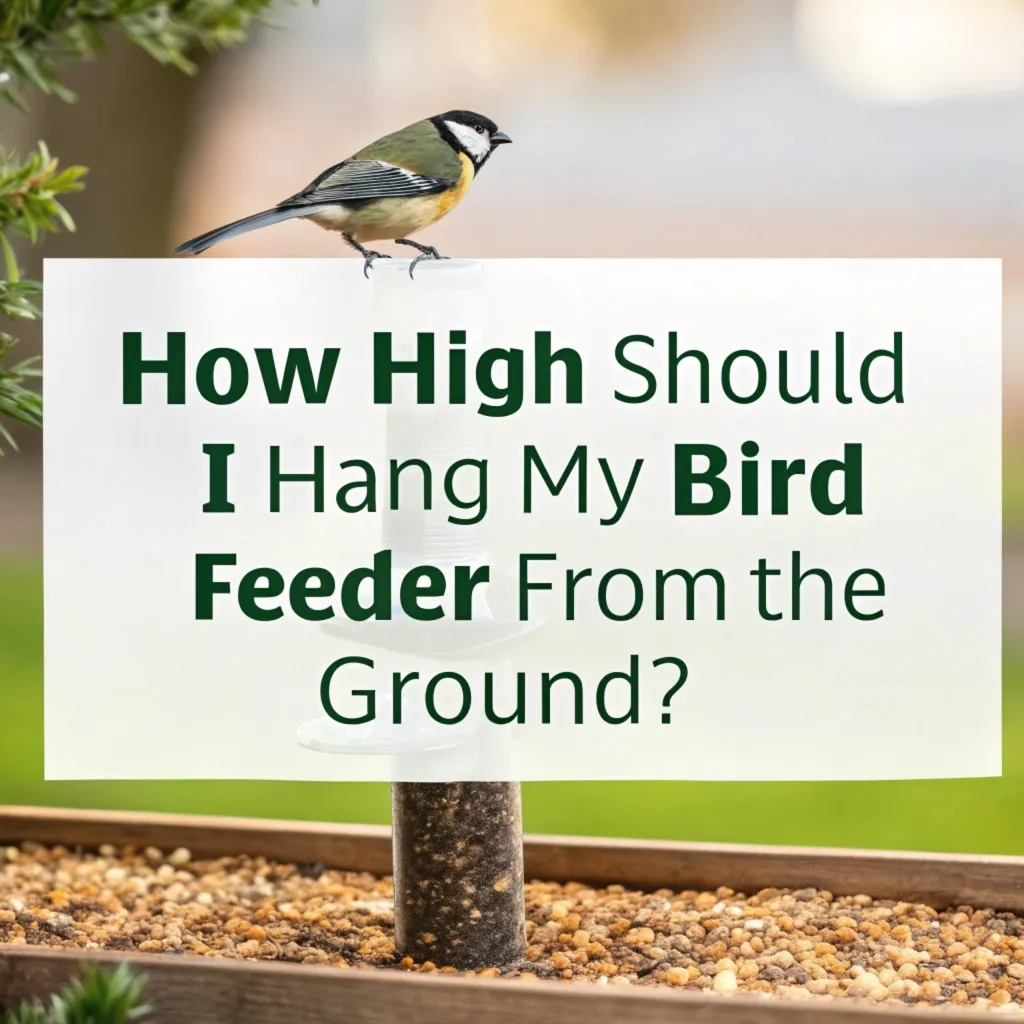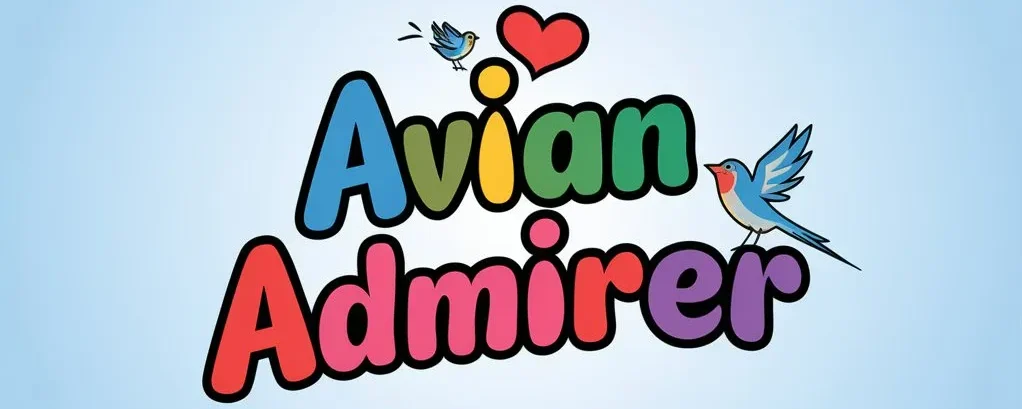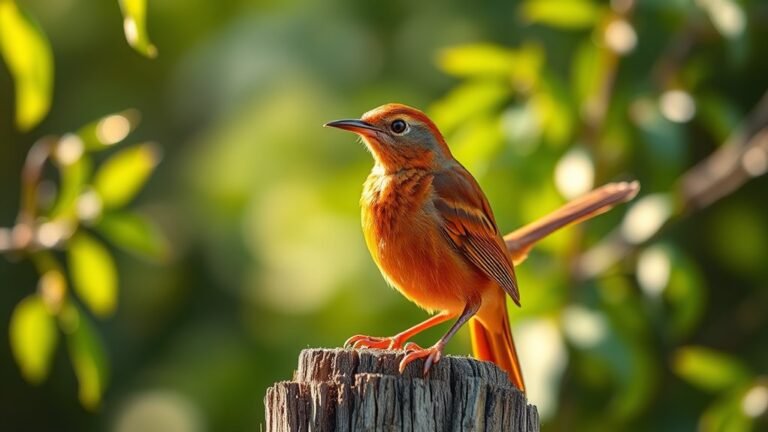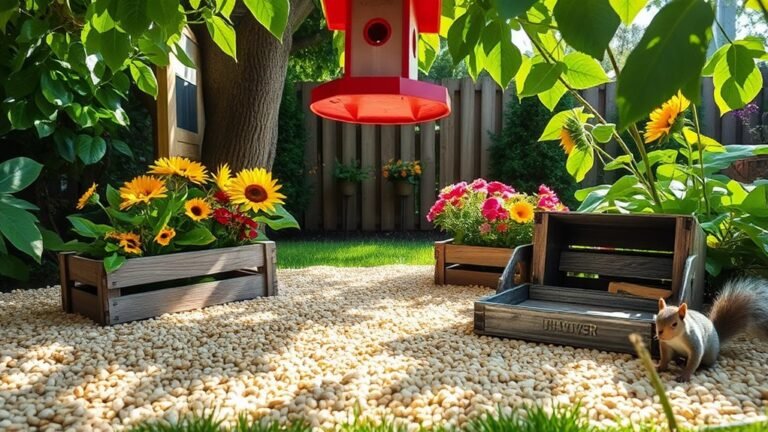How High Should I Hang My Bird Feeder from the Ground?
Bird feeders are a popular way to attract wildlife to your yard. However, the height at which you hang your feeder can significantly impact its effectiveness.
This guide will help you determine the best height for your bird feeder to attract a variety of birds while keeping them safe from predators.
We’ll explore the ideal heights for different types of feeders and bird species, as well as factors to consider when choosing a location.
By following these tips, you can create an inviting space for feathered visitors and enhance your birdwatching experience.
Key Takeaways
- Optimal height: 5 to 6 feet from the ground for most bird feeders
- Safety: Higher placement deters predators like cats
- Bird preferences: Different species prefer different feeding heights
- Accessibility: Consider your ability to refill and clean the feeder
- Squirrel deterrence: Place feeders away from jumping points
- Multiple feeders: Vary heights to attract diverse bird species
- Shelter: Position feeders near trees or shrubs for bird comfort
- Visibility: Ensure a clear line of sight for birds to spot predators
- Weather protection: Choose locations sheltered from strong winds
- Cleanliness: Regular cleaning is essential for bird health

Understanding Bird Feeding Heights
Birds feed at various heights in nature, reflecting their adaptations to different food sources. Ground-feeding birds like quail and juncos forage close to the earth, while warblers and kinglets prefer higher elevations in trees. This natural behavior influences the optimal placement of bird feeders in your yard.
Feeder placement is a crucial aspect of attracting birds to your yard. By understanding the natural feeding habits of different bird species, you can create a more inviting environment for a diverse array of feathered visitors.
Consider the vertical space in your yard as a series of feeding zones, each appealing to different types of birds.
Ideal Height for Common Backyard Birds
Most bird feeders perform best when positioned 5 to 6 feet above the ground. This height accommodates a wide range of popular backyard birds, including:
- Cardinals and finches: 5-6 feet
- Chickadees and titmice: 5-10 feet
- Woodpeckers: 6-10 feet
- Bluebirds: 5-7 feet
- Sparrows and towhees: 1-5 feet
Tailoring your feeder heights to specific bird species can significantly enhance your bird-watching experience.
While the 5-6 foot range is a good general guideline, experimenting with different heights can help you attract a wider variety of birds.
Pay attention to which species visit feeders at various heights and adjust accordingly for the best results.
Safety Considerations
Placing feeders at the right height enhances bird safety. A height of 5-6 feet helps protect birds from ground-based predators like cats. However, it’s crucial to position feeders away from bushes or structures that could conceal stalking predators.
Bird safety should be a top priority when setting up feeders. In addition to height, consider the surrounding environment.
Ensure there’s enough open space around the feeder for birds to easily spot approaching predators. This allows them to feed with greater confidence and reduces stress during their visits.
Accessibility for Humans
While considering bird preferences, ensure the feeder remains accessible for refilling and cleaning. A height of 5-6 feet allows most people to reach the feeder without requiring a ladder, promoting regular maintenance.
Convenience plays a significant role in maintaining a healthy feeding station. If feeders are too difficult to reach, you may be less likely to clean and refill them regularly.
Consider your own physical limitations and the tools you have available when deciding on feeder placement.
A well-maintained feeder at a slightly lower height is often better than a neglected one placed too high.
Squirrel Deterrence
Squirrels can jump about 5 feet vertically and 10 feet horizontally. To discourage squirrels, place feeders higher than 5 feet and at least 10 feet away from potential jumping points like trees or structures.
While squirrels can be entertaining to watch, they often outcompete birds at feeders and can cause damage.
In addition to height considerations, you might want to invest in squirrel-proof feeders or baffles.
These devices can help ensure that the food you put out is primarily enjoyed by your intended feathered guests.
Multiple Feeder Strategy
Hanging multiple feeders at various heights can attract a diverse range of bird species. This approach caters to different feeding preferences and reduces competition among birds.
A multi-feeder setup can transform your yard into a bustling bird sanctuary. Consider creating a feeding station with different types of feeders at various heights.
This not only attracts more species but also provides a fascinating opportunity to observe bird behaviors and interactions.
Remember to space feeders adequately to prevent dominant birds from monopolizing all food sources.

Shelter and Visibility
Position feeders near trees or shrubs to provide birds with quick shelter if threatened. Ensure feeders are visible from these safe perches, allowing birds to assess the feeding area before approaching.
The balance between shelter and visibility is crucial for bird comfort. While birds need nearby cover for safety, they also require a clear view of their surroundings while feeding.
Consider creating a landscape that offers both open areas and nearby refuges. This might include strategically placed shrubs, trees, or even artificial structures that provide perches and quick escape routes.
Weather Protection
Choose locations that offer some protection from strong winds and direct sunlight. This placement helps keep the feed dry and makes feeding more comfortable for birds.
Weather considerations are often overlooked but can significantly impact feeder effectiveness. In addition to wind and sun protection, think about rain and snow.
Feeders with good overhangs or weather guards can help keep food dry and prevent waste. During extreme weather events, consider providing extra food and ensuring water sources remain unfrozen to support your feathered visitors.
Types of Bird Feeders and Their Ideal Heights
Different feeder types suit various heights:
- Tray feeders: 1-5 feet, ideal for ground-feeding birds
- Hopper feeders: 5-6 feet, attract a wide range of species
- Tube feeders: 5-6 feet, perfect for small perching birds
- Suet feeders: 5-10 feet, favored by woodpeckers and nuthatches
- Platform feeders: 5-6 feet, accommodate larger birds
The variety of feeder types available allows you to create a diverse feeding environment. Each type of feeder not only suits different heights but also caters to specific feeding behaviors.
For example, tube feeders with small perches are great for finches and chickadees, while platform feeders can accommodate larger birds like jays and doves. Experiment with different feeder types to discover which work best in your yard.
Seasonal Adjustments
Consider adjusting feeder heights seasonally. In winter, when food is scarce, birds may be more willing to visit feeders at various heights. During breeding seasons, ground-feeding birds might appreciate lower-placed feeders.
Seasonal changes can significantly affect bird behavior and feeding patterns. In winter, birds may form mixed-species flocks and be more tolerant of each other at feeders.
During spring and summer, consider providing calcium-rich foods like eggshells to support breeding birds.
Be aware that nesting birds may have different preferences, so observe and adjust your feeding strategy accordingly throughout the year.
Maintenance and Cleanliness
Regardless of height, regular cleaning is essential. Clean feeders every two weeks, or more often in wet weather, to prevent the spread of diseases among birds.
Proper maintenance of your bird feeders is crucial for the health of your feathered visitors. In addition to regular cleaning, inspect feeders for any damage or wear.
Replace cracked or broken feeders promptly. Consider using a diluted bleach solution for thorough cleaning, and always ensure feeders are completely dry before refilling.
Remember, a clean feeder not only promotes bird health but also enhances your birdwatching experience.
Observing and Adapting
Monitor bird activity at your feeders and be prepared to adjust heights if needed. Different locations and bird populations may require unique setups for optimal feeding.
Birdwatching is a dynamic hobby that rewards patience and adaptability. Keep a journal of the birds you observe, noting which species visit which feeders and at what times.
This information can help you fine-tune your feeder placement and types of food offered.
Don’t be afraid to experiment with different setups – the birds will quickly let you know what works best through their feeding patterns.
FAQs
How high should I hang a hummingbird feeder?
Hang hummingbird feeders 3-6 feet off the ground, near flowering plants or in partially shaded areas.
Can I place bird feeders on the ground?
Ground feeding is natural for some birds, but elevating feeders reduces risks from predators and keeps food drier.
How far should bird feeders be from windows?
Place feeders either within 3 feet of windows to prevent fatal collisions or more than 10 feet away to give birds space to maneuver.
Should all my bird feeders be at the same height?
Varying feeder heights can attract a wider variety of bird species and reduce competition at feeding stations.
How often should I clean my bird feeders?
Clean bird feeders every two weeks, or more frequently during wet weather or if you notice sick birds.

Ava is a bird enthusiast and nature lover who has spent countless hours observing and learning about the fascinating world of birds. With a passion for sharing her knowledge and inspiring others to appreciate the beauty of birds, Ava writes about her experiences and insights on avianadmirer.com.







